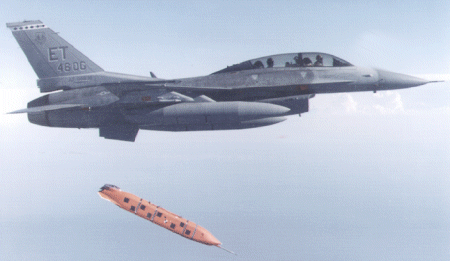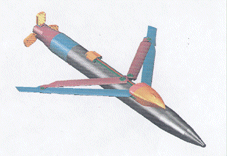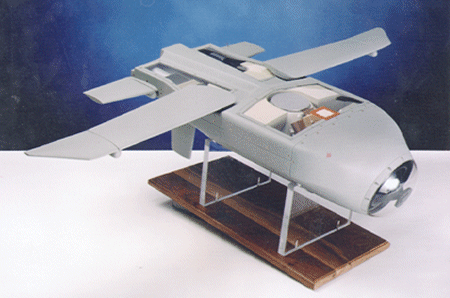Ramon Lopez/WASHINGTON DC

NATO's dependence on precision guided munitions (PGMs) is expected to grow in the coming years, when current-generation laser-guided bombs will be complemented by all-weather weapons using global positioning/inertial navigation system (GPS/INS) guiding and terminal-phase seekers able to track mobile targets.
Several air-to-ground weapons using GPS/INS guidance have made their debuts. They include the Boeing Joint Direct Attack Munition (JDAM), used exclusively by the Northrop Grumman B-2s of the US Air Force's 509th Bomber Wing during the air campaign over Yugoslavia.
Next in the evolution of the US military's PGMs will be the stealthy Lockheed Martin Joint Air-to-Surface Standoff Missile (JASSM), due to enter the USAF's weapons arsenal in 2002 to attack air defence systems and well-defended, hardened, fixed or relocatable high-value ground targets. Five years later, the USAF could field a new Miniaturised Munition Capability (MMC) against fixed, high-value targets and tank columns.
Meanwhile, weapons technology specialists at the Air Force Research Laboratory's Munitions Directorate at Eglin AFB, Florida, are working with industry to develop and demonstrate the technology needed to strike chemical or biological agent development, production and storage sites while minimising civilian deaths.
After launch, the Teledyne J402 turbojet-powered JASSM cruise missile flies autonomously over a low-level, circuitous route to a target area, where an autonomous terminal guidance system takes over. Mid-course guidance is provided by GPS/INS protected by an anti-jam system. In the terminal phase, JASSM is guided by an imaging infrared (IIR) seeker.
The second flight test of the AGM-158 JASSM will take place in late July or early August. In the meantime, a significant amount of ground testing can be completed on the next-generation weapon. JASSM programme director Terry Little is exercising caution because of the unceremonious end to the first JASSM flight evaluation on 8 April when the missile's wings and tail surfaces failed to deploy because of electrical current leakage. The AGM-158 prototype hit the ground 40s after cleanly separating from a Lockheed Martin F-16.
Little says the technical problem has been fixed, and should have little impact on the programme schedule if the next two test firings are successful. Lockheed Martin can expect to earn more than $2 billion for supplying at least 2,400 AGM-158s to the USAF and, eventually, the US Navy, which has agreed to buy an undisclosed number. Little says the USAF recently raised its inventory requirement to 3,700 missiles, and the USN has "growing interest" to buy JASSM, beginning in 2006/7 to arm the Boeing F/A-18E/F Hornet strike aircraft.
The low-observable missile is in engineering and manufacturing development, and limited production is to begin in January 2001, with annual peak production reaching 360. Plans call for JASSM to enter the USAF inventory in 2002. The F-16 and the Boeing B-52 bomber will be the first two delivery platforms.
The USAF is buying the first five JASSM production lots for an average unit price of $275,000 - 40% below the $400,000 target price. Little says Lockheed Martin is seeking permission to begin marketing an export variant of JASSM, and "informal talks" are under way with Australian defence officials.
A product-improved JASSM is under consideration. With a range of over 185km (100nm), a stretched, re-engined JASSM would be extended to about 1,850km, says Little. Williams International is known to be developing an advanced turbofan engine for the AGM-158. The powerplant's certification programme is believed to match the JASSM project's schedule.
JASSM is armed with a J1000 blast fragmentation warhead, but an incendiary device to destroy weapons of mass destruction is being explored. The IIR seeker may eventually be replaced by an all-weather synthetic aperture radar or a millimetre-wave seeker.
In January, Boeing, Lockheed Martin, Northrop Grumman and Raytheon evenly split $1 million from Eglin AFB's Air Armaments Center for short-term concept exploration studies to support an analysis of alternatives (AoA) for the Miniaturised Munition Capability (MMC) programme. The MMC builds from technology developed during the Munitions Directorate's Small Smart Bomb (SSB) range extension demonstration and powered Low Cost Autonomous Attack System (LOCAAS) demonstration. Other candidates are the Mk82 227kg (500lb) bomb with a JDAM tail kit, and the improved Northrop Grumman Brilliant Anti-Armor Technology (BAT) submunition.
The idea is to develop a 114kg-class munition in a modular system or family of weapons that is effective against a wide variety of targets, including hardened fixed sites, relocatable targets, tanks and missile batteries, previously vulnerable only to 900kg-class munitions. Such a weapon would increase the loadout capability of current and planned fighters and bombers, the unmanned combat air vehicles (UCAV) and the planned common air vehicle (CAV), a modified manoeuvrable re-entry vehicle. With each bomb independently targeted and autonomously guided, the number of kills per sortie would be tripled or even quadrupled.
The four US defence firms will present their reports, which will consider weapons performance and cost issues, to MMC programme manager Lynda Davila by September 2000. Davila says the Pentagon will then decide whether to launch a competitive joint services development/production programme beginning in fiscal year 2002 with the aim of fielding it as early as FY2007.

The SSB, which would attack fixed and relocatable targets, grew out of the Miniaturised Munition Technology Demonstration in which Boeing successfully demonstrated a 114kg smart bomb with a 19km range. Boeing, teamed with Alenia-Marconi Systems, is working under a $3.2 million, 18-month contract to conduct three SSB range extension flight tests in June 2000 using the latest Diamond Back wing kit (above), which could extend the weapon's range to 93km. SSB would incorporate GPS/INS navigation and a laser radar terminal seeker which would be tested in 2001-04.
LOCAAS, on the other hand, is a small, lightweight submunition with a laser radar terminal seeker and multi-mode warhead that is designed to be used against mobile targets. The warhead is an explosively formed penetrator that detonates as a single anti-armour slug or fragments for softer targets. Currently powered by the 50lb-thrust (0.22kN) Sundstrand TJ-50 miniature turbojet, a fighter could carry 16 LOCAAS and a bomber could carry nearly 100. Lockheed Martin Vought Systems is to conduct three flight tests of powered LOCAAS beginning in December 2000 as part of the $33 million advanced technical demonstration which runs until the end of 2001.

Project engineers recently redesigned LOCAAS to enhance its performance, resolve controllability problems and slash production costs. The new design, with increased wingspan and a wider body, allows for more fuel, additional endurance beyond 30min, and a range exceeding 185km. The cost target for LOCAAS is $33,000 a copy. The USAF, meanwhile, hopes to award a contract for developing and demonstrating an anti-chemical and biological agent warhead to fit a range of 900kg guided air-to-surface munitions used to attack hard and soft fixed targets. The Agent Defeat Warhead (ADW) is intended to neutralise such agents without any dispersal. Various options are being studied, including a high-temperature incendiary device (which was demonstrated two years ago), low-blast fragmenting warheads and neutralising chemicals.
The selected contractor will conduct a 42-month demonstration in two phases. The first would include trade studies, preliminary design and fabrication of a prototype for static testing. Phase 2 would include detailed design and a dynamic delivery test.
The Munitions Directorate earmarked $16 million for ADW but saw its funding slashed to $7.3 million, resulting in the programme being stretched. The contract was due to be awarded before 30 September, but project officials have decided that none of the bids received by the 29 April deadline was "of sufficient merit to warrant an award", adding: "The acquisition strategy for this programme is under re-evaluation." It is unclear when the USAF would reopen bidding for the ADW project. Officials suggest the programme's objectives may be relaxed to keep the demonstration alive.
Australia has signalled interest in a similar type of munition to equip a 185km-range stand-off weapon to be carried by its Boeing F/A-18s or General Dynamics F-111s. A collaboration has not been raised, but USAF officials say an international effort would be desirable.
"We are interested in seeing what technology Australia is developing," says one USAF official. "We would like to compare technologies. We are interested in an international collaboration where it makes sense."
Source: Flight International























